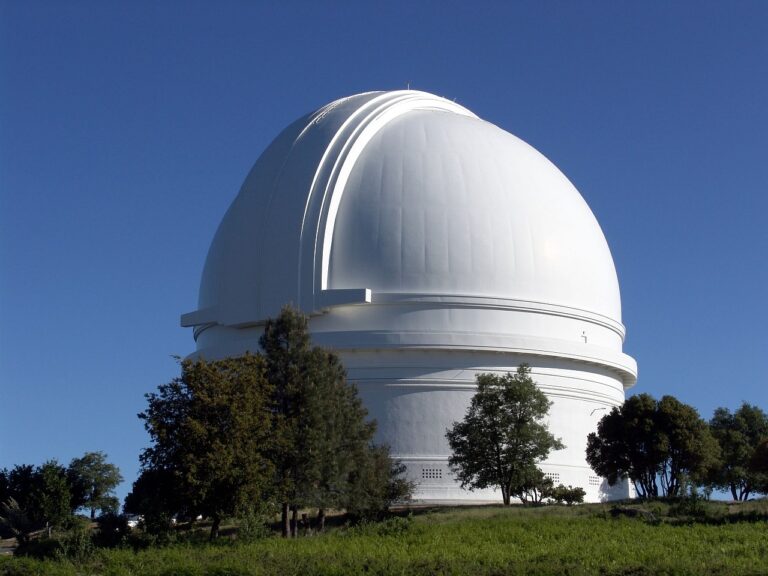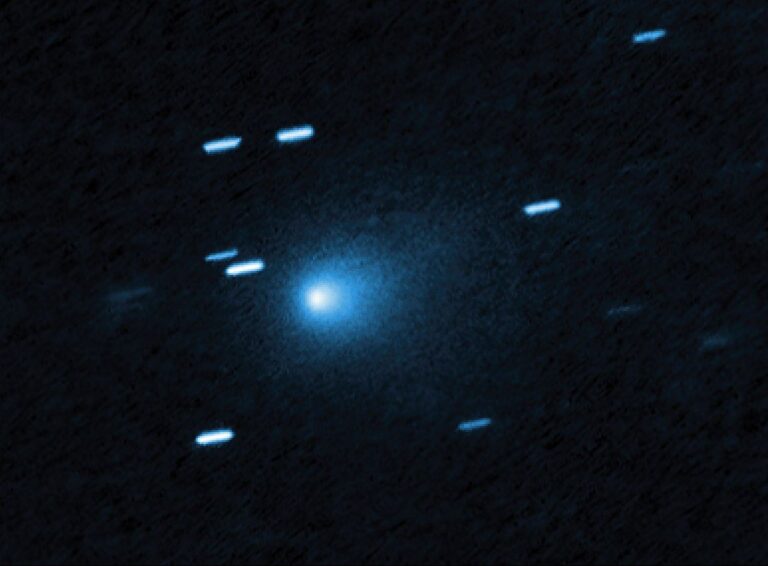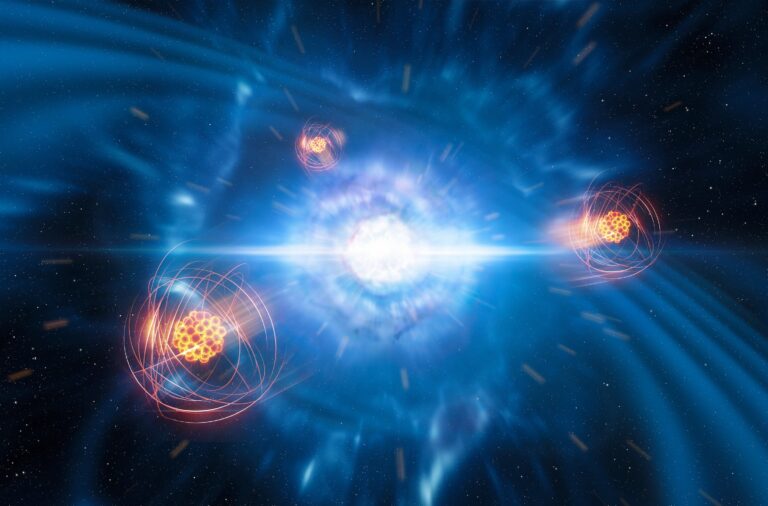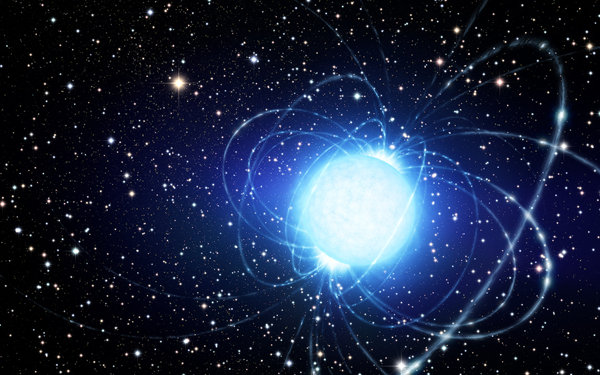
Key Takeaways:
- Neutron stars are incredibly dense, city-sized remnants of massive stars.
- They form after a supernova when gravity overcomes electron degeneracy pressure.
- Some neutron stars, called pulsars, emit regular radiation pulses.
- Magnetars are neutron stars with extremely strong magnetic fields.
It isn’t a secret that humanity and everything around us is made of star stuff. But not all stars create elements equally. Sure, regular stars can create the basic elements: helium, carbon, neon, oxygen, silicon, and iron. But it takes the collision of two neutron stars — incredibly dense stellar corpses — to create the heavier elements like silver, gold, and platinum.
Neutron stars aren’t just notable for the valuable elements they create, though. They’re also a dream come true for physicists. From their crushing gravity to the universe’s strongest magnetic fields, extremes of physics are the norm for neutron stars. And, unlike black holes, these exotic objects are observable. “It’s hard to study black holes,” says Samar Safi-Harb, the Canada research chair in supernova remanent astrophysics at the University of Manitoba in Winnipeg, Canada. “With neutron stars, you can do a lot more. You can really probe the interior, there’s a surface you can study, and you can measure a lot of its properties.”
Creating a neutron star
Before you can get this ideal cosmic laboratory, a star first has to die. The end of a star’s life depends largely on its mass. Unremarkable stars like the Sun go out with a relatively quiet whimper compared to their more massive cousins, whose deaths are announced with fireworks.
During most of their lifetimes, stars perform a careful balancing act between the inward force of gravity and the outward pressure caused by nuclear fusion in their cores. Eventually, however, a star will run out of material to burn. Stars like the Sun are limited to an initial hydrogen burning phase — the Sun’s will continue for another 4 billion years — followed by a shorter helium burning phase of about 2 billion years.
Massive stars, on the other hand, have many more phases, allowing for the nuclear fusion of hydrogen, helium, carbon, neon, oxygen, and, finally, silicon. After the silicon is gone, the star’s core is composed of iron. Unfortunately for the star, however, no further energy can be gained from burning iron, so the process stops there. Once such a star runs out of fuel for nuclear fusion, the pressure pushing the star outward loses out and gravity quickly takes over. The star implodes, its outer layers collapsing inward.
At this point, the star’s fate lies with the principles of quantum physics. Matter is composed of atoms, which in turn are made up of electrons, protons, and neutrons. All these particles are part of a special class of elementary particles known as fermions. These kinds of particles have a crucial property that comes into play when a star is imploding: Identical fermions cannot exist in the same place at the same time. This rule is called the Pauli exclusion principle.
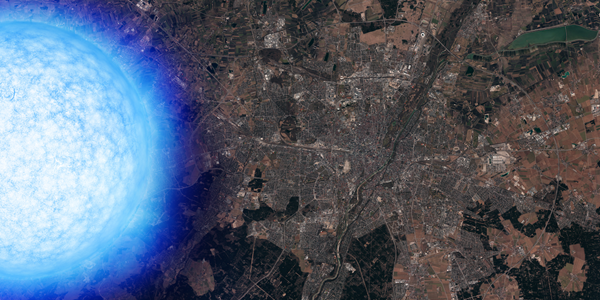
So, as the outer layers of the star are crushed into the core, the fermions in the star’s center are packed together. The electrons orbiting the nucleus of an atom are the first to feel the squeeze. Unable to be forced any closer together, they produce their own kind of outward pressure, known as electron degeneracy pressure. This halts the progress of gravity, causing the material outside the core to be thrown off. The result is a white dwarf. Ultimately, stars like the Sun will end their life as these stellar remnants.
For more massive stars, however, gravity wins another battle here. The electrons are squeezed closer and closer to the neutron-proton core of their atom until they merge with the protons, creating more neutrons and some neutrinos. The neutrinos can zip out of the star freely, but the neutrons are crushed closer together until they exert their own gravity-fighting degeneracy pressure, creating a neutron star. In the most extreme cases, gravity overcomes even this force, winning the war and forming a black hole.
Neutron star basics
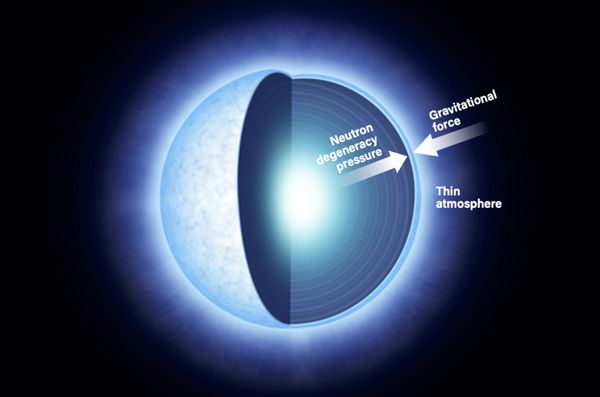
Similar to black holes, neutron stars were predicted to exist long before we observed them. In 1934, astronomers Walter Baade and Fritz Zwicky published a paper in the Proceedings of the National Academy of Sciences of the United States of America titled “Cosmic Rays from Super-Novae.” They proposed that supernovae (a term they also coined) produce both the mysterious cosmic rays spotted coming from outside our galaxy and “the transition of an ordinary star into a neutron star.” They further described these objects as “possess[ing] a very small radius and an extremely high density.”
It took another 30 years for astronomers to discover the first neutron star. In 1967, Jocelyn Bell Burnell, an astronomy graduate student working for Antony Hewish at Cambridge University, spotted a weak, repeating signal using a large radio telescope at the Mullard Radio Astronomy Observatory. At first, Hewish and Bell Burnell wondered if they’d found proof of “little green men,” but the two quickly dismissed that idea. Instead, they realized they had picked up on an unusual star exhibiting the exact characteristics Baade and Zwicky had proposed three decades prior.
Since the discovery, researchers have uncovered a whole menagerie of neutron stars with varying properties. But there are a few basic characteristics that these stars exhibit across the board.
Just as Baade and Zwicky predicted, neutron stars are incredibly small. The average neutron star has a diameter of roughly 12.5 miles (20 kilometers), or about the size of a city. And packed within that small volume is a Sun’s worth of mass. Just one sugar-cube-sized block of neutron star material would weigh about 1 billion tons.
Those aren’t the only extreme properties of neutron stars. They also spin at mind-boggling speeds. Thanks to a basic rule of physics — conservation of angular momentum — compact neutron stars can spin themselves up to a much higher rate than that of their progenitor star. Imagine a twirling figure skater. When their arms are outstretched, they spin slowly, but as they pull their arms in, they speed up. The same is true for stars. After a supernova, the remnant has a significantly smaller diameter and thus spins much faster than its progenitor. The fastest spinning neutron star, PSR J1748-244ad, makes 716 rotations per second.
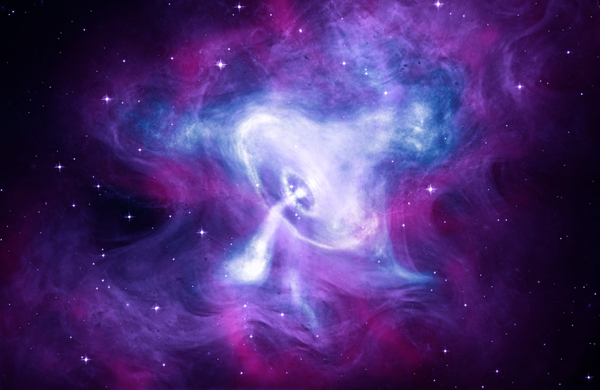
Over time, however, like the figure skater, a neutron star’s spin will peter out. This is thanks to the magnetic field that encircles the neutron star, which acts like an opposing force that ultimately puts the brakes on the star’s rotation.
That effect isn’t surprising, considering the strength of a neutron star’s magnetic field, which is orders of magnitude greater than any other found in the universe. How exactly these objects generate such high magnetic fields isn’t well understood. Like their spin rate, it’s partially to do with the progenitor star’s magnetic field being conserved when it collapses into a smaller object. But that effect alone isn’t enough to explain the magnetic field strength seen in neutron stars.
While their magnetic field and spin may be extreme, neutron stars aren’t very brilliant in visible light. Approximately 2,000 neutron stars have been identified in the Milky Way and Magellanic Clouds. At first, that may sound like a lot, but astronomers estimate there are a billion neutron stars hiding in our Milky Way alone.
There are a few reasons for this disparity. Most neutron stars are old. With only one supernova occurring in our galaxy every 50 years, that’s not surprising. As they age, neutron stars cool down and fade in brightness, making them nearly invisible. But even young neutron stars can be difficult to spot. More often than not, astronomers have to rely on happy cosmic accidents to find a previously unknown neutron star.
Pulsars: Testing the speed limit
One characteristic can make a neutron star easy to find. Many of them emit continuous beams of radiation from opposing hemispheres. And if the neutron star is spinning at just the right orientation relative to Earth, that beam may repeatedly sweep across our planet. This breed of neutron star is known as a pulsar — the class of objects that Bell Burnell discovered in 1967. When they spin, they look to radio telescopes like flickering stars in the night sky.
And boy, do pulsars spin. The fastest spinning neutron star — the previously mentioned PSR J1748-244ad — is actually a pulsar or, more precisely, a millisecond pulsar. These speedy pulsars get their name from having spin periods in the milliseconds, whereas normal neutron stars spin in the seconds range. The amped-up speeds of millisecond pulsars are likely thanks to a cosmic partner: A pulsar in a binary system can pull in material from its companion to “spin up” its rate of rotation into the millisecond range.
Typically, the radiation emitted from a pulsar tends to be at radio wavelengths; however, a few optical, X-ray, and gamma-ray pulsars have been discovered. The most famous example of an optical pulsar is the neutron star at the center of the Crab Nebula.
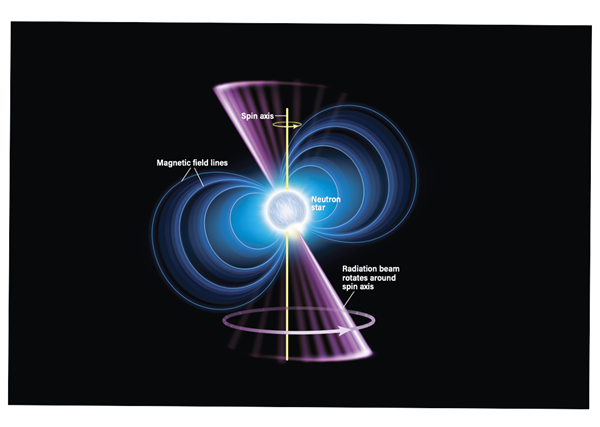
The timing of the pulses is incredibly predictable — so predictable that you could set your watch to them, literally. The European Space Agency has a project called PulChron to do just that. Using pulsar measurements collected from the European Pulsar Timing Array, PulChron monitors 18 of the most regular pulsars in the night sky. The large sample size helps to weed out any timing anomalies caused by passing gravitational waves, or ripples in the fabric of space-time, resulting from random cosmic events. According to the researchers, in the short term, atomic clocks — which keep time using the resonance frequencies of atoms — are better. But in the long term, neutron star clocks will outlive an atomic clock. Currently PulChron is used in conjunction with an active hydrogen maser atomic clock at the Time and Geodetic Validation Facility of Galileo.
Pulsars aren’t just great for keeping track of time. Scientists think they can also be used to track Earth’s motion through space. Groups like the North American Nanohertz Observatory for Gravitational Waves (NANOGrav), Australia’s Parkes Pulsar Timing Array, and the European Pulsar Timing Array are training their eyes on a large number of well-understood millisecond pulsars to create a kind of gravitational-wave positioning system. Like a GPS unit on Earth uses satellites to determine your location, astronomers want to use pulsars to accurately determine Earth’s position. The goal is to use that data to detect when gravitational waves pass through Earth and slightly alter its position. One of the sources of these Earth-altering gravitational waves could be the merger of two supermassive black holes. Living at the hearts of most galaxies, supermassive black hole mergers give off gravitational waves whose frequency is too low for the Laser Interferometer Gravitational-wave Observatory and Virgo collaborations to detect, but NANOGrav would be able to pick them up.
A neutron star with an identity crisis
NASA’s Neil Gehrels Swift Telescope discovered the 31st magnetar, Swift J1818.01607 or J1818 for short, in March 2020. Researchers followed up with observations using NASA’s Chandra X-ray Observatory. Aside from being the latest magnetar discovered, it turns out that J1818 is even more special: It is the youngest known magnetar, at a mere 500 years old. This gives researchers the opportunity to observe a time in a magnetar’s life they’ve never seen before.
But its young age isn’t the only unique aspect of J1818: The star is also the fastest-spinning magnetar, whirling around once every 1.4 seconds. And researchers say the magnetar’s rotation rate is already slowing as it ages, meaning it likely started out spinning even faster.
And if J1818 wasn’t already exotic enough, it also joins a group of only five known magnetars that act like pulsars. While magnetars typically emit lots of X-rays and gamma rays, J1818 was also observed giving off regular radio pulses. Curiously, J1818 initially appeared more pulsarlike than the four other known radio-loud magnetars. Whereas those objects emitted pulses that were bright across the radio-wave spectrum, a typical pulsar — and J1818 — is brighter at longer wavelengths.
While astronomers watched it between June and July 2020, J1818 flickered between pulsarlike and magnetar-like radio pulse emissions. Over the course of 15 days, it settled down into a permanent magnetar-like state.
Magnetars: The more magnetic cousins
While pulsars may be the most reliable neutron stars, magnetars are the troublemakers of the family.
The magnetic field around a magnetar is about a thousand trillion times stronger than Earth’s and often somewhere between 100 to 1,000 times stronger than a pulsar’s. But a super-strong magnetic field doesn’t come without its setbacks: “Magnetars are exploding, and you see gamma-ray bursts and X-ray bursts and crazy rotational anomalies,” says Victoria Kaspi, a neutron star and radio transient researcher at McGill University in Montreal, Quebec.
Magnetars can also emit more pulsarlike emissions, but the difference between the two is clear to those that study them. “The radio emission is different, it looks different, it smells different,” explains Kaspi. “In radio pulsars, it’s like a lovely little pulse and it comes every time. But in magnetars it’s like boom, boom, boom.” So where pulsars are fairly predictable, emissions from magnetars are more random.
Besides being more erratic, magnetars are also more difficult to find than pulsars. Of the 2,000 neutron stars so far discovered throughout the Milky Way, only 31 are definitively classified as magnetars. So, little is understood about these exotic objects. But what we do know paints a pretty impressive picture.
In 2001, a mysterious radio signal passed over our planet, carrying in just 5 milliseconds as much energy at radio wavelengths as the Sun emits in an entire month. This fast radio burst (FRB) went unnoticed until 2007 and came from a source so far away it was impossible to even pin down. But when the next few FRBs struck Earth in 2013 and 2017, researchers were ready. Unfortunately, finding the cause of FRBs still proved to be a challenge. Although astronomers could track the 2017 signal back to a galaxy some 3 billion light-years away, most FRBs are too sudden and random to pin down more precisely.
Models suggested that magnetars could be the culprits behind FRBs. But the magnetars observed in our galaxy had never exhibited behavior that would suggest these remnants could be capable of launching FRBs energetic enough to reach us from across the universe. To track down a Milky Way FRB, researchers trained their eyes on a single magnetar, SGR 1935+2154. And it did not disappoint. In early 2020, Earth caught a glancing blow from an FRB launched by this object. This detection cemented the connection between FRBs and magnetars, although there is still room for other objects to also cause FRBs.
Neutron stars, kilonovae, and magnetars, oh my!
When stars collide, the result is often explosive. That’s especially true when they are a pair of super-dense stellar remnants like neutron stars. The fireworks show, called a kilonova, unleashes more energy than the Sun will produce during its 10-billion-year lifetime. Kilonovae shine as a result of the radioactive decay of heavy elements — like gold and platinum — that are produced during the merger and blasted outward. These events last less than two seconds and produce short gamma-ray bursts.
And wouldn’t you know it, the light from one such collision reached Earth on May 22, 2020. After traveling nearly 5.5 billion light-years, the brilliant flash was first detected by NASA’s Neil Gehrels Swift Observatory. Then, telescopes across the world quickly turned their eyes to the aftermath of the explosion.
As the most luminous kilonova event on record, the find was already groundbreaking, resulting in some of the most detailed observations to date. But data from the Hubble Space Telescope took that even further. When light from this event, GRB 200522A, reached Earth, Hubble observed the event across the across a broad swath of the electromagnetic spectrum, finding the event’s infrared emissions 10 times greater than predicted. The most likely explanation, researchers say, is that the remnant of the collision was feeding energy into the emission.
“We don’t know the upper mass limit of neutron stars and the lower mass limit of black holes,” says Wen-Fei Fong of Northwestern University, lead author of the study. “But if you take two neutron stars and smash them together — and you assume most of that mass ends up in the new object — then more than likely you’re going to be in the regime of black holes.” But not all of that mass is going into that new object, making it possible to instead form a so-called heavy neutron star. These heavy neutron stars are thought to be unstable, collapsing into a black hole in a handful of milliseconds.
Researchers suspect that the collision formed a heavy magnetar, creating the perfect storm to power the resulting kilonova. A magnetar’s magnetic field lines whipping around can deposit some of the rotational energy from the newly formed object into the ejecta, causing that material to glow brighter than expected.
If true, this will be the first time researchers have seen evidence of merging neutron stars giving birth to a magnetic monster. In order to know for certain, scientists will have to keep their eyes trained on this area of the sky. If a magnetar really is lighting it up, then within a few years, the ejected material from the burst will begin appearing in radio wavelengths.
“If we hadn’t looked with the right telescopes, we would have never known this was a weird feature,” says Fong. “I’ve been studying short gamma-ray bursts for over 10 years now, and I’m just amazed that [the universe] never ceases to throw surprises our way. So, I’m excited for when we start detecting more of these [gamma-ray] sources.”
Missing puzzle pieces
Despite their ability to tell us about the universe around us, there’s plenty researchers don’t understand about neutron stars themselves.
For starters, we don’t even have a close-up image of one. In 2019, the world was taken by storm when the Earth-spanning Event Horizon Telescope released the first image of a black hole’s shadow. Its target was the solar system-sized supermassive black hole at the heart of M87, which lies 54 million light-years away. But even though the nearest neutron star, RX J185635-3754, is only 200 light-years distant — significantly closer than M87 — it’s still too tiny to get an up-close image of with our current telescopes. “Neutron stars are just 10 to 15 kilometers [in diameter] no matter what, so it’s very hard to image such an object,” says Safi-Harb.
Scientists also have no idea what neutron stars’ interiors look like. That’s because physics predicts that deep inside the cores of neutron stars, the pressure exerted by gravity is too strong even for degenerate neutrons to withstand.
Neutron stars, like normal stars, are composed of layers. It’s easiest to think of them as consisting entirely of neutrons, but that isn’t actually the case. Astronomers believe neutron stars have a thin layer of atmosphere composed of hydrogen and helium. Beneath that lies a thin layer of outer crust — less than an inch thick — containing electrons unattached to a nucleus and atomic nuclei. In the inner crust, those electrons and nuclei become packed together. Some of the electrons combine with protons in lighter nuclei to make neutrons, while heavier atomic nuclei are spared. The outer core is where the neutron-rich environment begins. And beyond that is the inner core, whose composition physicists can only guess at.
“Once you get to the core of the neutron star, something has changed there. The density there is too high for this [neutron degeneracy pressure] picture [as we understand it],” says Kaspi. Some theories point to pressure from quarks — the particles that make up protons and neutrons — as the force holding up the inner core. Alternatively, a new particle might be responsible. Figuring out exactly which model holds up requires more data, however.
One way to rule out some of those models is to find more massive neutron stars. “For every model, there is some maximum mass above which it collapses into a black hole,” says Kaspi. And astronomers don’t quite know yet where the boundary between black holes and neutron stars lies. The most massive neutron star, PSR J0740+6620, is 2.1 solar masses, whereas the smallest black hole found, dubbed the Unicorn, weighs in at 3 solar masses.
In 2017, astronauts deployed the Neutron star Interior Composition Explorer (NICER) on to the International Space Station. NICER is the first dedicated neutron star mission and is therefore, according to Safi-Harb, “the best experiment to address the question [of what is at the heart of a neutron star].”
Understanding what’s going on at the core of a neutron star would also help explain what’s going on outside as well — namely, with its magnetic field. Originally, theorists believed that the magnetic fields around neutron stars were mostly dipoles, with the north and south sides emerging from opposite sides of the object. But recent observations have revealed that they aren’t that simple. Take the pulsar J0030+0451, which was observed by NICER in 2019. Based on those observations, simulations predict the possibility of two or even three separate magnetic fields emerging from the southern hemisphere of the object alone.
Though mysteries abound when it comes to neutron stars, astronomy is entering a golden era. And thanks to the LIGO/Virgo collaborations, researchers have a new tool in gravitational waves to study the cosmos with. LIGO has managed to capture just two binary neutron star mergers, but scientists are hopeful the observatory will discover more in the coming years. “There are a lot of big telescopes being built across the electromagnetic spectrum,” says Safi-Harb. “It is the synergy of all these telescopes together with gravitational waves that I’m most excited about, because there will be room for lots of discoveries and surprises that we didn’t even anticipate.”
And with each new neutron star discovered, astronomers are learning more about these compact objects, including that the neat categories they expected are more like a sliding spectrum. Some magnetars have been observed to exhibit more pulsarlike behavior and vice versa. Even stranger, the Chandra X-ray Observatory discovered what researchers are calling anti-magnetars. They appear to be neutron stars with uncharacteristically low magnetic fields. In the past decade, about two dozen of these strange objects have been found at the heart of supernovae remnants.
“This is why I do this kind of astronomy,” says Kaspi. “Neutron stars are just really cool.”
Editor’s note: This article was first published in the October 2021 issue of Astronomy.






